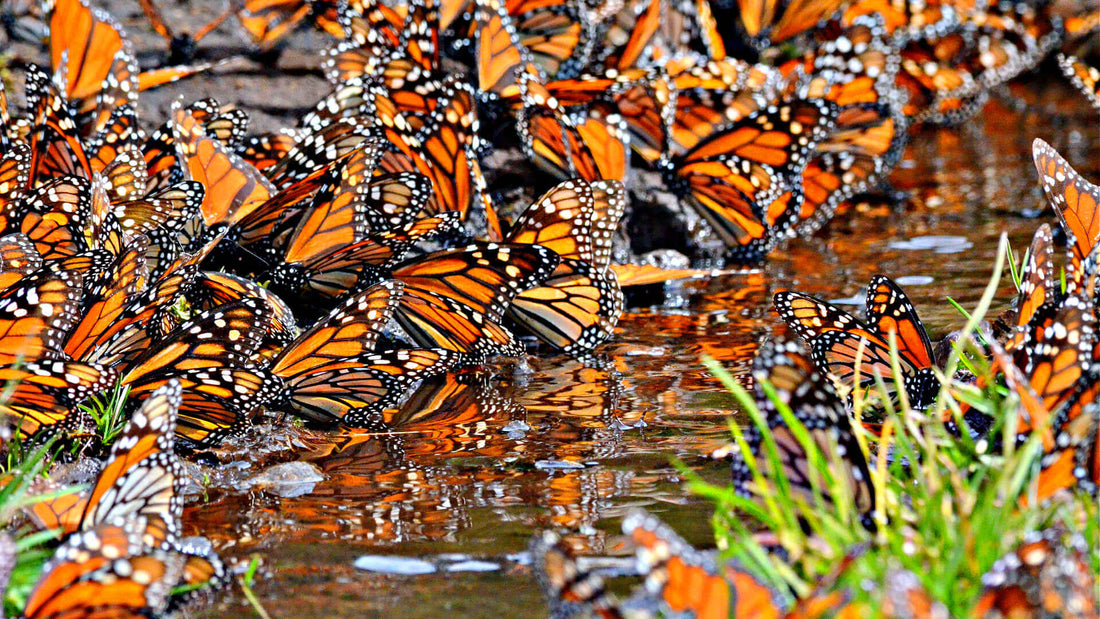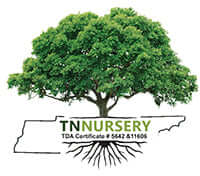
State Butterflies of the USA: A Colorful Journey
Share
State butterflies are a unique and cherished symbol of individual U.S. states. Each state has its own designated butterfly, chosen for its significance and representation of the state's natural beauty and heritage. Butterflies play a crucial role in ecosystems, serving as pollinators and indicators of environmental health. In this article, we'll explore the state butterflies of all 50 U.S. states and the plants that attract them.
USA State Butterflies
Alabama - Eastern Tiger Swallowtail (Papilio glaucus) The Eastern Tiger Swallowtail, Alabama's state butterfly, is a beautiful yellow and black butterfly that can be attracted to various nectar-rich plants. Some favorites include butterfly bushes, milkweed, and phlox.
Alaska - None Alaska does not have an official state butterfly, likely due to its cold climate, which is not conducive to many butterfly species.
Arizona - Two-tailed Swallowtail (Papilio multicausal) The Two-tailed Swallowtail, Arizona's state butterfly, can be attracted to various wildflowers. They are particularly fond of thistles, milkweeds, and desert marigolds.
Arkansas - Diana Fritillary (Speyeria diana) The Diana Fritillary, the state butterfly of Arkansas, enjoys the nectar of wildflowers like black-eyed Susans, asters, and milkweeds.
California - California Dogface Butterfly (Zerene eurydice) To attract the California Dogface Butterfly, California gardeners can plant native species like California lilac, California buckwheat, and other California wildflowers.
Colorado - Colorado Hairstreak (Hypaurotis crystals) Colorado Hairstreaks are drawn to nectar-rich plants such as penstemons, milkvetches, and other native wildflowers commonly found in Colorado gardens.
Connecticut - Eastern Tiger Swallowtail (Papilio glaucus) Like their counterparts in Alabama, Connecticut's Eastern Tiger Swallowtails are attracted to various nectar sources, including lilies, phlox, and butterfly bushes.
Delaware - Eastern Tiger Swallowtail (Papilio glaucus) Delaware's state butterfly, the Eastern Tiger Swallowtail, can be encouraged to visit gardens by planting flowers like Joe-Pye weed, black-eyed Susans, and milkweeds.
Florida - Zebra Longwing (Heliconius charithonia) To attract Florida's Zebra Longwing, plant nectar-rich flowers like passionflowers, lantanas, and wild sage. These butterflies are especially fond of passionflower vines. OLOLOLOLOLOLOL Georgia - Eastern Tiger Swallowtail (Papilio glaucus) Gardeners in Georgia can invite Eastern Tiger Swallowtails by planting azaleas, butterfly bushes, and other colorful flowers that offer nectar.
Hawaii - Kamehameha Butterfly (Vanessa Kamehameha) The Kamehameha Butterfly, unique to Hawaii, is attracted to native Hawaiian plants like 'ohi'a lehua and 'akala. Gardeners in Hawaii can promote these native plants in their gardens.
State Butterflies Love Milkweed
Idaho - Monarch Butterfly (Danaus plexippus) Idaho's state butterfly, the Monarch, relies on milkweed as a host plant for its larvae. Planting milkweed varieties native to Idaho, such as Showy Milkweed (Asclepias speciosa), can help attract Monarchs.
Illinois - Monarch Butterfly (Danaus plexippus) The Monarch Butterfly, representing Illinois, also relies on milkweed as its primary host plant. Planting milkweed species like Common Milkweed (Asclepias syriaca) can aid Monarch conservation.
Indiana - Monarch Butterfly (Danaus plexippus) Indiana's state butterfly, the Monarch, can be attracted by planting milkweed varieties like Swamp Milkweed (Asclepias incarnata) and Butterfly Weed (Asclepias tuberosa).
Iowa - Eastern Goldfinch (Spinus tristis) The Eastern Goldfinch, Iowa's state butterfly (a bird), is attracted to gardens with sunflowers, coneflowers, and native wildflowers. These plants provide both nectar and seeds for these birds.
Kansas - Painted Lady Butterfly (Vanessa Cardui) Painted Lady Butterflies in Kansas enjoy nectar from various flowers, including thistles, asters, and other native wildflowers.
Kentucky - Viceroy Butterfly (Limenitis archippus) The Viceroy Butterfly, representing Kentucky, can be encouraged to visit gardens by planting willow and poplar trees (host plants for their larvae) and offering nectar-rich flowers like asters and goldenrods.
Louisiana - Eastern Tiger Swallowtail (Papilio glaucus) Louisiana's Eastern Tiger Swallowtails are attracted to many garden favorites, such as zinnias, phlox, and black-eyed Susans.
Maine's state insect, the White Pine Cone and Tassel (Pinus strobus), represents the state's abundant white pine forests. However, Maine doesn't have an official state butterfly.
Maryland - Baltimore Checkerspot (Euphydryas phaeton) To attract Maryland's state butterflies, the Baltimore Checkerspot plants native wildflowers like black-eyed Susans and milkweeds, which provide nectar for adult butterflies.
Massachusetts - Black Swallowtail Butterfly (Papilio polyxenes) The Black Swallowtail Butterfly, Massachusetts' state butterfly, can be drawn to gardens by planting nectar-rich flowers such as fennel and dill.
Michigan - Monarch Butterfly (Danaus plexippus) Monarchs, representing Michigan, are reliant on milkweed as their host plant. Michigan gardeners can support Monarchs by planting native milkweed species like Common Milkweed and Swamp Milkweed.
Minnesota - Monarch Butterfly (Danaus plexippus) The Monarch Butterfly, Minnesota's state butterfly, can be attracted by planting milkweed species like Common Milkweed, Butterfly Weed, and Swamp Milkweed.
Mississippi - Spicebush Swallowtail (Papilio troilus) To attract Mississippi's state butterfly, the Spicebush Swallowtail, consider planting nectar sources such as butterfly and joe-pye weed in your garden.
Missouri - Eastern Black Swallowtail (Papilio polyxenes) The Eastern Black Swallowtail, Missouri's state butterfly, can be encouraged to visit gardens by planting herbs like dill and parsley, as well as milkweed for nectar.
Montana - Mourning Cloak Butterfly (Nymphalis antiopa) Montana's state butterfly, the Mourning Cloak, can be attracted to gardens by planting flowering plants like asters and native trees such as oaks and willows.
Nebraska - Western Swallowtail Butterfly (Papilio rutulus) Western Swallowtail Butterflies in Nebraska are drawn to native wildflowers, including penstemons, milkvetches, and other nectar-rich plants commonly found in the state.
Nevada - Mourning Cloak Butterfly (Nymphalis antiopa) Nevada's state butterfly, the Mourning Cloak, can be attracted to gardens with native plants like asters, willows, and oaks that provide nectar and host plants.
New Hampshire - Karner Blue Butterfly (Plebejus melissa samuelis) The Karner Blue Butterfly, New Hampshire's state butterfly, depends on lupine as a host plant for its larvae. Gardeners can help by planting native lupine species.
New Jersey - Eastern Black Swallowtail (Papilio polyxenes) The Eastern Black Swallowtail, New Jersey's state butterfly, is attracted to various garden plants, including dill, parsley, and milkweed.
New Mexico - Sandia Hairstreak (Callophrys mcfarlandi) New Mexico's state butterfly, the Sandia Hairstreak, can be encouraged to visit gardens by planting native plants like Apache plume and cliffrose.
New York - Eastern Tiger Swallowtail (Papilio glaucus) The Eastern Tiger Swallowtail, shared with several other states, can be attracted to New York gardens by planting nectar-rich flowers like lilies and phlox.
North Carolina - Eastern Tiger Swallowtail (Papilio glaucus) North Carolina's Eastern Tiger Swallowtails are drawn to various garden plants, including azaleas, black-eyed Susans, and milkweeds.
North Dakota - Monarch Butterfly (Danaus plexippus) Monarchs, North Dakota's state butterflies, rely on milkweed as their host plant. Planting native milkweed species like Showy Milkweed can support these butterflies.
Ohio - Ohio's State Butterfly (Papilio glaucus) Ohio's state butterfly, the Ohio State Butterfly, shares its name with the Eastern Tiger Swallowtail and is attracted to similar nectar sources like phlox, lilies, and butterfly bushes.
Oklahoma - Black Swallowtail Butterfly (Papilio polyxenes) The Black Swallowtail Butterfly, representing Oklahoma, can be attracted to gardens by planting nectar-rich flowers such as fennel, dill, and milkweed.
Oregon - Oregon Swallowtail (Papilio Oregonians) The Oregon Swallowtail, unique to the state, is attracted to nectar from native plants like milkweeds and thistles.
Pennsylvania - Eastern Tiger Swallowtail (Papilio glaucus) Pennsylvania's state butterfly, the Eastern Tiger Swallowtail, can be drawn to gardens with nectar-rich flowers such as zinnias, phlox, and black-eyed Susans.
Rhode Island - American Copper Butterfly (Lycaena phlaeas) The American Copper Butterfly, Rhode Island's state butterfly, can be attracted to gardens by planting native wildflowers such as asters and goldenrods.
South Carolina - Eastern Tiger Swallowtail (Papilio glaucus) South Carolina shares its state butterfly, the Eastern Tiger Swallowtail, with several other states. Gardeners can attract them with azaleas, butterfly bushes, and other nectar-rich plants.
South Dakota - White-faced Meadowhawk (Sympetrum obtuse) South Dakota's state butterfly, the White-faced Meadowhawk (a dragonfly), can be drawn to gardens with water features and native plants like wild bergamot and goldenrods.
Tennessee - Zebra Swallowtail Butterfly (Eurytides marcellus) The Zebra Swallowtail Butterfly, representing Tennessee, is attracted to nectar sources like common milkweed and other native wildflowers.
Texas - Monarch Butterfly (Danaus plexippus) The Monarch Butterfly, shared with many other states, relies on milkweed as its host plant. Texas gardeners can plant native milkweed species like Green Milkweed (Asclepias viridis).
Utah - Mourning Cloak Butterfly (Nymphalis antiopa) Utah's state butterfly, the Mourning Cloak, can be attracted to gardens with native flowering plants like thistles and oaks.
Vermont - Monarch Butterfly (Danaus plexippus) Vermont's state butterfly, the Monarch, depends on milkweed as its host plant. Planting native milkweed species like Swamp Milkweed can support these butterflies.
Our State Butterflies Are Important
Virginia - Eastern Tiger Swallowtail (Papilio glaucus) Virginia's Eastern Tiger Swallowtails are attracted to various garden plants, including phlox, lilies, and butterfly bushes.
Washington - Swallowtail Butterfly (Papilio machaon oregonius) The Swallowtail Butterfly of Washington can be attracted to gardens with nectar sources like milkweeds and thistles.
West Virginia - Monarch Butterfly (Danaus plexippus) West Virginia, like many other states, recognizes the Monarch Butterfly as its state butterfly. Milkweed is vital for their survival in West Virginia.
Wisconsin - Western Honey Bee (Apis mellifera) Wisconsin's state insect is the Western Honey Bee, which can be attracted to gardens with various flowering plants, particularly those with nectar-rich blooms.
Wyoming - Sheridan's Green Hairstreak (Callophrys sheridanii) Wyoming's state butterfly, Sheridan's Green Hairstreak, can be encouraged to visit gardens by planting native wildflowers like buckwheat and sagebrush.
In conclusion, attracting state butterflies to your garden often involves planting native flowering plants and host species. By providing the right plants, you can create a habitat that not only supports these beautiful butterflies but also contributes to the overall health of local ecosystems and pollinators. Be sure to consider the specific needs of each butterfly species and plant accordingly to help conserve these valuable creatures for generations to come.
